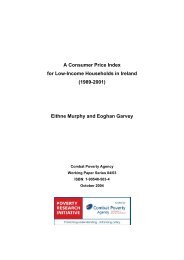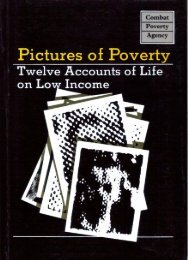The Distribution of Income in Ireland (2000) - Combat Poverty Agency
The Distribution of Income in Ireland (2000) - Combat Poverty Agency
The Distribution of Income in Ireland (2000) - Combat Poverty Agency
- No tags were found...
You also want an ePaper? Increase the reach of your titles
YUMPU automatically turns print PDFs into web optimized ePapers that Google loves.
26 <strong>The</strong> <strong>Distribution</strong> <strong>of</strong> <strong>Income</strong> <strong>in</strong> <strong>Ireland</strong>those rely<strong>in</strong>g on social welfare lagged beh<strong>in</strong>d the overall meanbetween 1994 and 1997, the size <strong>of</strong> that group decl<strong>in</strong>ed significantlyfrom 30 per cent to 24 per cent <strong>of</strong> the sample, reduc<strong>in</strong>gthe between-group component <strong>of</strong> <strong>in</strong>equality.<strong>The</strong>se decomposition results clearly provide valuable <strong>in</strong>sights<strong>in</strong>to the structure <strong>of</strong> <strong>in</strong>come <strong>in</strong>equality <strong>in</strong> <strong>Ireland</strong> and howit has been chang<strong>in</strong>g. This is approached from another perspective<strong>in</strong> the next section, where we look at where differenttypes <strong>of</strong> household tend to be located <strong>in</strong> the <strong>in</strong>come distributionand how that has been evolv<strong>in</strong>g.3.5 WHO IS WHERE IN THE INCOME DISTRIBUTION?We beg<strong>in</strong> by look<strong>in</strong>g at the location <strong>of</strong> persons <strong>in</strong> the <strong>in</strong>comedistribution categorised by the age <strong>of</strong> the head <strong>of</strong> the household<strong>in</strong> which they live, and focus on the proportion fall<strong>in</strong>g <strong>in</strong>toeach qu<strong>in</strong>tile <strong>of</strong> the disposable equivalised <strong>in</strong>come distributionamong persons. (We employ qu<strong>in</strong>tiles — successive one-fifths<strong>of</strong> the distribution — rather than deciles <strong>in</strong> order to see theoverall pattern more easily.) We see first <strong>in</strong> Figure 3.2 thatpeople <strong>in</strong> households headed by someone aged between 35and 64 were spread rather evenly over the qu<strong>in</strong>tiles <strong>in</strong> both1994 and 1997. In 1994 those <strong>in</strong> households headed by someoneaged under 35 were relatively heavily concentrated <strong>in</strong> boththe bottom and the top qu<strong>in</strong>tile, but by 1997 they were moreconcentrated at the top. In 1994 those <strong>in</strong> households headed bysomeone aged 65 or over were heavily concentrated <strong>in</strong> thesecond qu<strong>in</strong>tile from the bottom. By 1997, however, the proportionat the top <strong>of</strong> the distribution had fallen and the numbers<strong>in</strong> the bottom qu<strong>in</strong>tile had risen markedly. <strong>The</strong> short periodbetween 1994 and 1997 thus saw a considerable change at boththe top and bottom <strong>of</strong> the distribution, to the advantage <strong>of</strong>younger households and the disadvantage <strong>of</strong> older ones.<strong>The</strong> <strong>Distribution</strong> <strong>of</strong> <strong>Income</strong> <strong>in</strong> the 1990s 27Figure 3.2: Position <strong>in</strong> the <strong>Income</strong> <strong>Distribution</strong> <strong>of</strong> PersonsCategorised by Age <strong>of</strong> Household Head, 1994 and 1997 LITSurveys*199445 Y'403530- '25-20H$^H18-1050Head Aged Under Head Aged 35-64 Head Aged 65 or35 Over45403530252015105ni1997i £ a0Head Aged Under Head Aged 35-64 Head Aged 65 or35 Over* See Table A2.2 <strong>in</strong> Appendix 2 for data.• Bottom02S3• 4DTop• Bottom• 2S3• 4DTopTable 3.9 dist<strong>in</strong>guishes those liv<strong>in</strong>g <strong>in</strong> households headed by acouple or a s<strong>in</strong>gle man and those headed by a woman. We seethat the latter are significantly more heavily concentrated towardsthe bottom <strong>of</strong> the <strong>in</strong>come distribution, and that their proportion<strong>in</strong> the bottom qu<strong>in</strong>tile <strong>in</strong>creased from one-quarter toover one-third between 1994 and 1997.
















